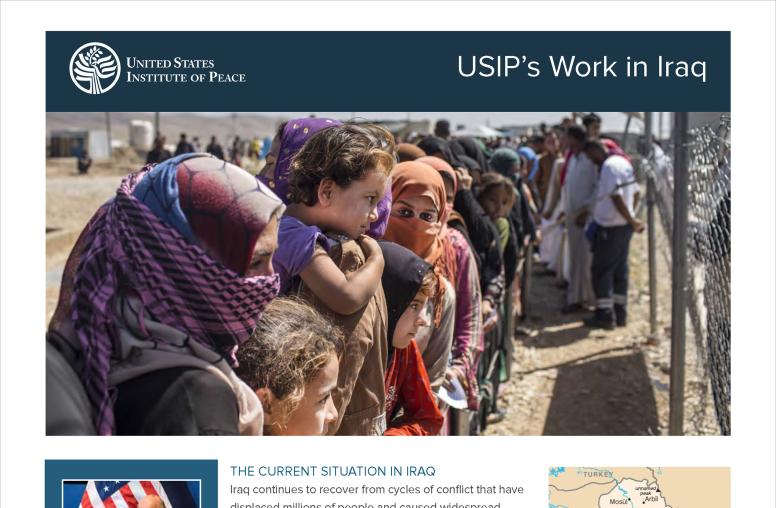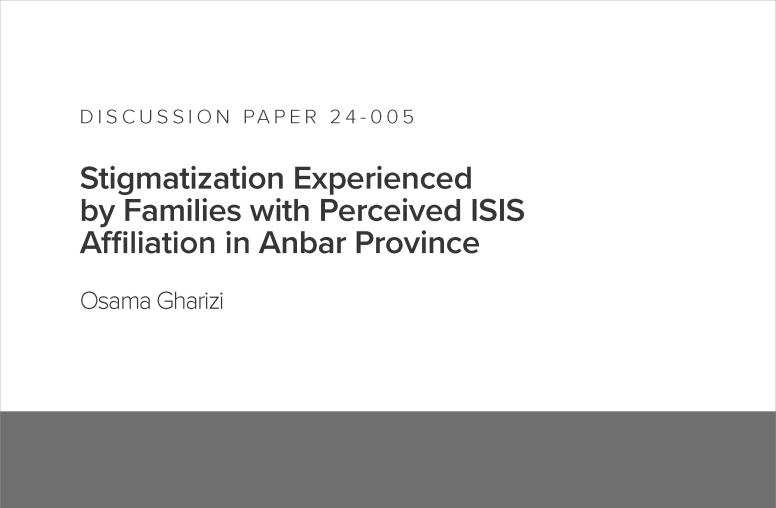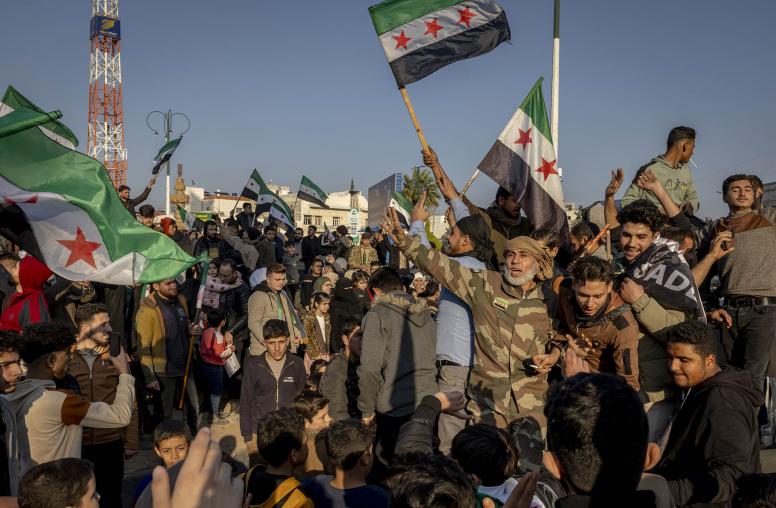What Will Become of Iraqis in Al-Hol?
In October, Kurdish authorities announced 24,000 Syrians would be released. But the camp’s Iraqi residents’ future is as uncertain as ever.
The al-Hol camp in northeast Syria—which holds tens of thousands who were living among ISIS before its territorial defeat—has presented the region and international community with a host of thorny challenges. What to do with the camp’s residents has particularly bedeviled the Kurdish authorities who run the camp as well as the governments of countries where residents came from. On October 5, Kurdish authorities said they would release the Syrians in the camp, where conditions have become increasingly unsustainable. But, nearly half of the camps’ 65,000 residents are Iraqis, and their prospect for return remains deeply uncertain. USIP’s Sarhang Hamasaeed discusses the situation facing Iraqis in al-Hol and the challenges ahead if they indeed return.

In early October, Kurdish authorities in Syria announced they would release the 24,000 Syrians in al-Hol. What about Iraqis in al-Hol?
With a lack of political will and security concerns over actual or perceived affiliation with ISIS, the prospect for Iraqis in al-Hol to return to their communities remains uncertain. At least in the past two years, the Iraqi government and international organizations have been talking about plans for their return. Although the Iraqi government has said it is willing to take them back, progress has been slow and mostly limited to the government collecting information about who is in the camp and starting some preparations in Ninewa Province to settle them there.
International organizations have also been hesitant to support some of the Iraqi government’s ideas, which may have amounted to creating detention centers. The Kurdistan Regional Government has voiced its objection to the Baghdad government on settling al-Hol residents in disputed territories or hosting them in the Kurdistan region.
There has also been communal resistance. Internally displaced persons (IDPs) residing in camps in Ninewa objected to bringing al-Hol residents to their camp because they think it will taint their reputation and further complicate their own complex situation and return. Minority communities, especially Christians and Yazidis (Ezidis) who have suffered genocide at the hand of ISIS, have opposed the idea of hosting al-Hol returnees in Ninewa. They have also advocated for removing from Ninewa Plain a court investigating terrorism cases and a prison holding ISIS fighters and suspects, namely in the city of Tal Kaif.
Meanwhile, many Iraqis in al-Hol are reluctant to return for the fear of capital punishment or acts of revenge. Syrian officials in the Syrian Democratic Council (SDC) and Syrian Democratic Forces (SDF) have also indicated their concerns over returnees facing capital punishment in Iraq. COVID-19 and other political, security, and economic developments have added to these barriers. In August, Iraq’s minister of migration and displacement, Evan Jabro, told a USIP audience that Iraq is prepared to repatriate 8,000 women and children—which is about the number of people who seem to be willing to return to Iraq. That remains to happen.
In what way are those Iraqis in al-Hol associated with ISIS? What challenges do they face if they are able to return?
It is hard to accurately identify how, or if, these Iraqis are associated with ISIS, although the perception on the Iraqi side is that they are either all affiliated with ISIS or accepted to live under their rule. Iraqi community and civil society leaders flagged adverse conditions for Iraqis in al-Hol as early as 2016, when the camp was mostly unheard of and had a smaller population. At that time, the perception was that they were either Sunni Arabs who ran away from ISIS or armed Iraqi forces they feared would target them. Then the number mushroomed rapidly after the final territorial defeat of ISIS in Baghouz, Syria in March 2019.
On top of the horrible conditions in al-Hol, residents are vulnerable to recruitment and exploitation by ISIS affiliates in the camp. The longer people remain, the higher the risk they adhere to ISIS under duress or by choice. If they return to Iraq, they face the risk of capital punishment, long-term detention or prison, communal revenge, isolation, and the lasting stigma of ISIS affiliation or support. This could then easily lead to social, economic, and political ostracization, and a communal and institutional attempt at “De-ISIS-fication,” a process of exclusion or isolation of Iraqis and Syrians by authorities or communities on both sides of the border.
The Iraqi government has recently performed another round of IDP camp closures, a move received with mixed reactions. It was welcomed by those who have been calling for getting people home for political or humanitarian reasons. Still others, including humanitarian organizations and IDPs, are concerned that this could violate the principles of safe and voluntary return and risk violence to those who are already extremely vulnerable. Leaving al-Hol or camps inside Iraq requires special preparations—safety, lodging, addressing economic needs, and social integration—which are not in place.
What kind of support is required for these Iraqis upon return and what can the international community do to help?
It is critical to keep attention on the issues in al-Hol and to continuously remind relevant Iraqi, Syrian, and global interlocutors of the humanitarian imperatives and principles that need to be upheld, while trying to chip away at this unprecedented problem. The international community can also continue providing much needed humanitarian and other specialized support—food, shelter, health, psycho-social support, training, and legal services—while also working with authorities, civil society organizations, and community leaders to problem-solve the wide-range of issues al-Hol has become a symbol of.
The U.S.-led Global Coalition to Defeat ISIS and members of the international community have put varying levels of policy and programmatic effort into issues related to the human legacy of the conflict with ISIS. However, the magnitude and complexity of the problem is such that it requires scaled up and sustained long-term engagement from both the international community and relevant government and communal stakeholders in Iraq, Syria, and other countries from which ISIS fighters and affiliates came. Otherwise, the alternative is grim, especially for thousands of children who are in al-Hol.
Speaking at a USIP event in August, Gen. Kenneth F. McKenzie Jr., commander of U.S. Central Command, emphasized the importance of dealing with those who have been displaced by the conflict with ISIS: “The enduring defeat of ISIS has got to incorporate a way forward for the displaced persons and all the people that are at risk across the theater; if not, we are actually never really going to defeat ISIS and the problem is going to come back.” Unless this problem is resolved, he said, “We are setting a strategic barrier for ourselves 10 to 15 years down the road as these children grow older, as they are radicalized.”
Where do Iraq and Syria intersect when it comes to lessons for dealing with the human legacy of ISIS?
The circumstances and actors are not exactly the same, but it would be appropriate to draw some lessons from the experience on both sides of the border in dealing with deep political and communal divisions, combined with a heavy human legacy of fighting extremism.
In 2012 and 2013, Iraq had thousands of Sunni Arabs, both men and women, in detention or prison, accused of terrorism, including affiliation with al-Qaida or as it called itself, the Islamic State of Iraq. Iraq did not have sufficient judicial capacity or political will to address the problem as the number of detainees was growing. This added to a growing schism between the Sunni population, especially the tribes, and the Shia-led government. Ultimately those Sunni communities turned against the Iraqi government and either supported or gave safe passage to ISIS. The Iraqi government did not heed warning signs of what was sure to come.
A similar situation may be playing out in eastern Syria today. In the past few years, but particularly the past few months, the Kurdish-led SDC/SDF have heard from Sunni Arab tribes in eastern Syria that they are unhappy with their situation—unsatisfactory political representation, insecurity, lack of services, etc.—with thousands of their community members remaining in detention or in camps. Releasing detainees who do not have blood on their hands and allowing thousands of IDPs to leave camps may relieve the pressure to a certain extent. But it is uncertain if that would be enough. The Assad regime and other actors may continue their efforts to destabilize the area. Meanwhile, both Iraq and Syria suffer from their neighbors’ destabilizing roles in the region.
De-ISIS-ification could lead to keeping thousands of people vulnerable to extremist organizations, armed groups, and criminal organizations. De-Baathification in Iraq had similarly negative effects well before ISIS took large swathes of Iraq and Syria. Women and children are particularly vulnerable to exploitation whether by extremist groups, or simply because of the weak position they are under now. These are long-term matters that go well beyond releasing people from detention or IDP camps—hence the need for specialized, scaled up, and sustained programming.
The Iraqi experience has also shown that keeping thousands in detention centers for a sustained period of time only makes them more vulnerable to radicalization, which fueled the rapid advancement of ISIS. Many a-Hol residents came from either a radicalized context or were co-existing with radical elements who wanted to sustain ISIS. Community and government leaders are divided on how to address these issues. Many agree that isolation is not a solution, but they will also not accept ISIS families as their neighbors. Jabro underscored that the most effective strategy for disengaging former ISIS supporters from extremist ideology and networks is to return and reintegrate them into their communities.
The conflict with ISIS left tens of thousands of people stuck with actual or perceived ISIS affiliation. Most are unable to go home, and their isolation makes matters worse if fighters and members are not given a path to disengage from violence, reintegrate into society, and reconcile with their communities. Facilitated dialogues have been an effective avenue for chipping away at this problem and advancing coexistence.
The U.S. Institute of Peace and its local partners have successfully worked with community leaders and authorities in Iraq, and to a more limited extent in northeast Syria, to sort through the different shades of the human legacy of ISIS. This includes efforts such as: moving authorities and communities to more standardized, legal-based security vetting; focusing on individual suspects as opposed to collective accusation and punishment against entire communities, tribes, and families; bridging intra- and inter-community relations and community-state relations; and leveraging the role of tribal and other community leaders in reducing tensions, preventing violence, and removing barriers to the return of IDPs, including those around whom concerns of affiliation with ISIS existed but were not proven.



